Effectiveness and Costs: Robotic vs. Laparoscopic Colorectal Surgery
VerifiedAdded on 2020/04/15
|49
|9564
|442
Report
AI Summary
This report presents a systematic review comparing the effectiveness and cost-efficiency of robotic-assisted surgery versus laparoscopic surgery for colorectal cancer treatment. The study examines various research articles to evaluate surgical outcomes, including patient recovery time, blood loss, and hospital stays. The review addresses the research question: 'Is the surgical outcome and cost of robotic-assisted surgery more effective than Laparoscopic surgery for colorectal cancer?' The background literature review encompasses multiple trials conducted over the past five years, comparing the two surgical methods. The methodology outlines the research protocol, PICOS framework, search strategy, study selection criteria, and quality assessment methods. The report analyzes the advantages and disadvantages of each surgical approach, considering factors such as operative time, complications, and long-term oncological outcomes. The primary aim is to determine which surgical method provides better results in terms of cost-effectiveness and surgical outcomes for colorectal cancer patients. The report concludes with limitations, suggestions for the dissemination of research findings, and a comprehensive list of references.
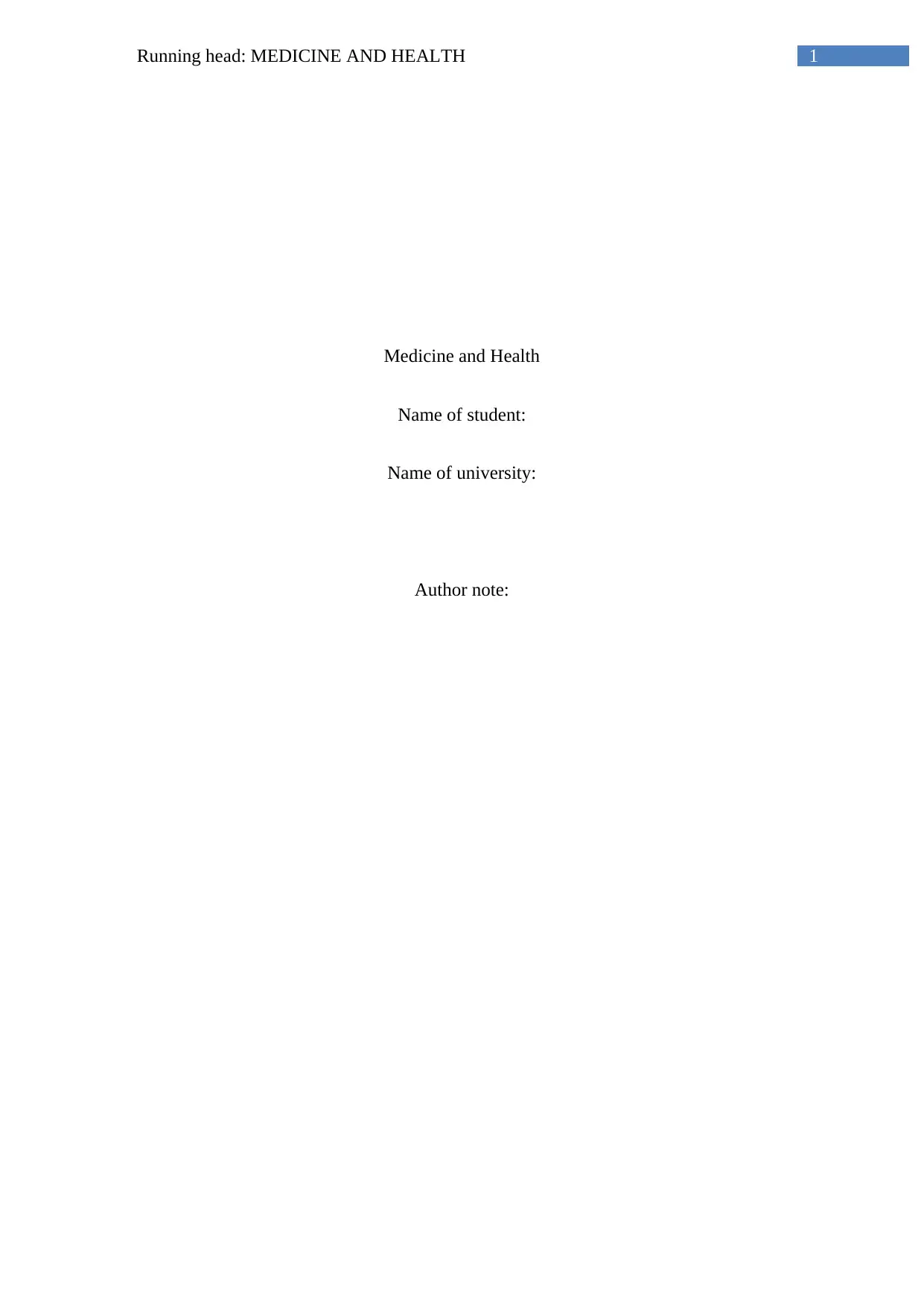
1Running head: MEDICINE AND HEALTH
Medicine and Health
Name of student:
Name of university:
Author note:
Medicine and Health
Name of student:
Name of university:
Author note:
Paraphrase This Document
Need a fresh take? Get an instant paraphrase of this document with our AI Paraphraser
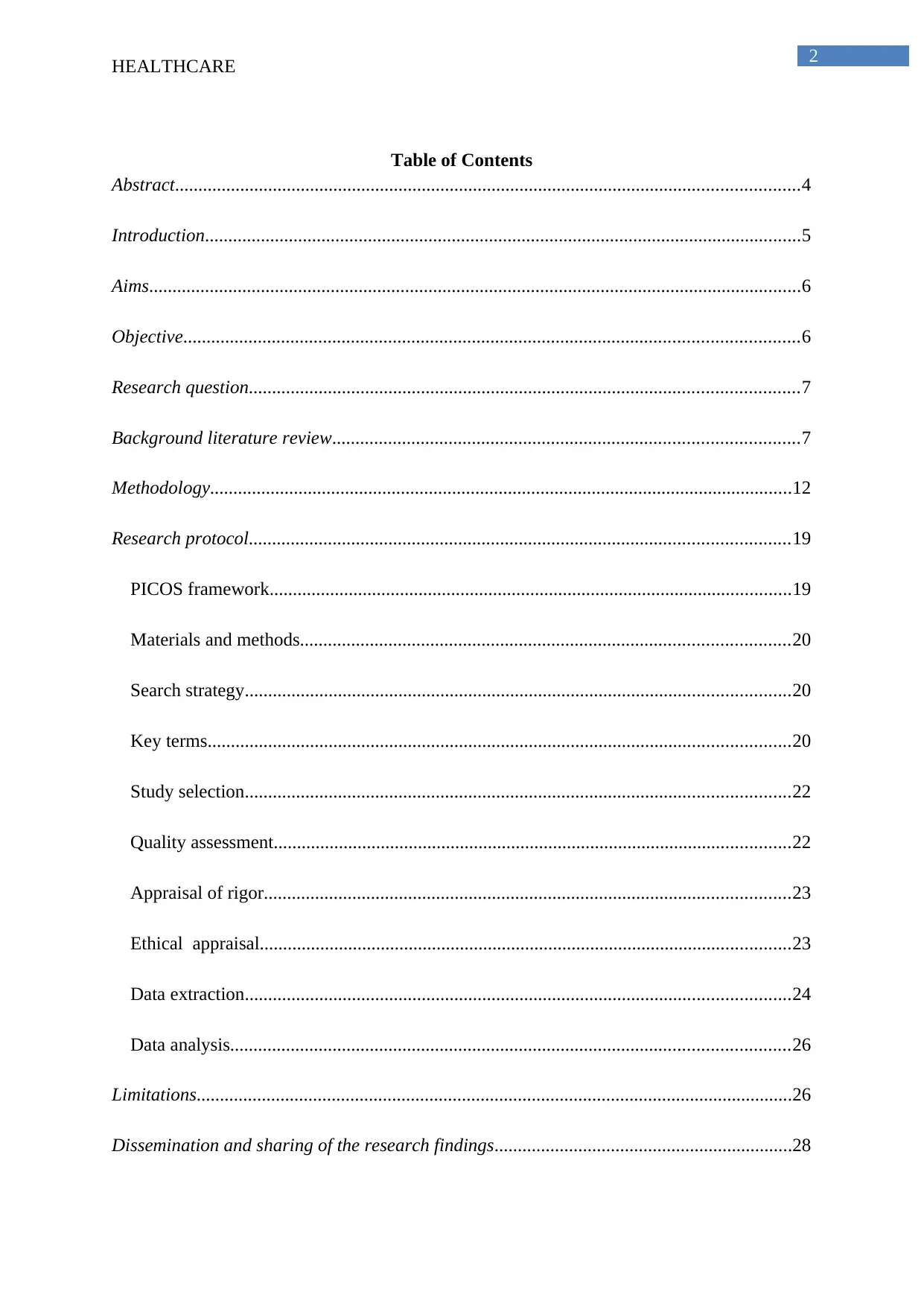
2
HEALTHCARE
Table of Contents
Abstract......................................................................................................................................4
Introduction................................................................................................................................5
Aims............................................................................................................................................6
Objective....................................................................................................................................6
Research question......................................................................................................................7
Background literature review....................................................................................................7
Methodology.............................................................................................................................12
Research protocol....................................................................................................................19
PICOS framework................................................................................................................19
Materials and methods.........................................................................................................20
Search strategy.....................................................................................................................20
Key terms.............................................................................................................................20
Study selection.....................................................................................................................22
Quality assessment...............................................................................................................22
Appraisal of rigor.................................................................................................................23
Ethical appraisal..................................................................................................................23
Data extraction.....................................................................................................................24
Data analysis........................................................................................................................26
Limitations................................................................................................................................26
Dissemination and sharing of the research findings................................................................28
HEALTHCARE
Table of Contents
Abstract......................................................................................................................................4
Introduction................................................................................................................................5
Aims............................................................................................................................................6
Objective....................................................................................................................................6
Research question......................................................................................................................7
Background literature review....................................................................................................7
Methodology.............................................................................................................................12
Research protocol....................................................................................................................19
PICOS framework................................................................................................................19
Materials and methods.........................................................................................................20
Search strategy.....................................................................................................................20
Key terms.............................................................................................................................20
Study selection.....................................................................................................................22
Quality assessment...............................................................................................................22
Appraisal of rigor.................................................................................................................23
Ethical appraisal..................................................................................................................23
Data extraction.....................................................................................................................24
Data analysis........................................................................................................................26
Limitations................................................................................................................................26
Dissemination and sharing of the research findings................................................................28

3
HEALTHCARE
References................................................................................................................................29
Appendices...............................................................................................................................37
HEALTHCARE
References................................................................................................................................29
Appendices...............................................................................................................................37
⊘ This is a preview!⊘
Do you want full access?
Subscribe today to unlock all pages.

Trusted by 1+ million students worldwide
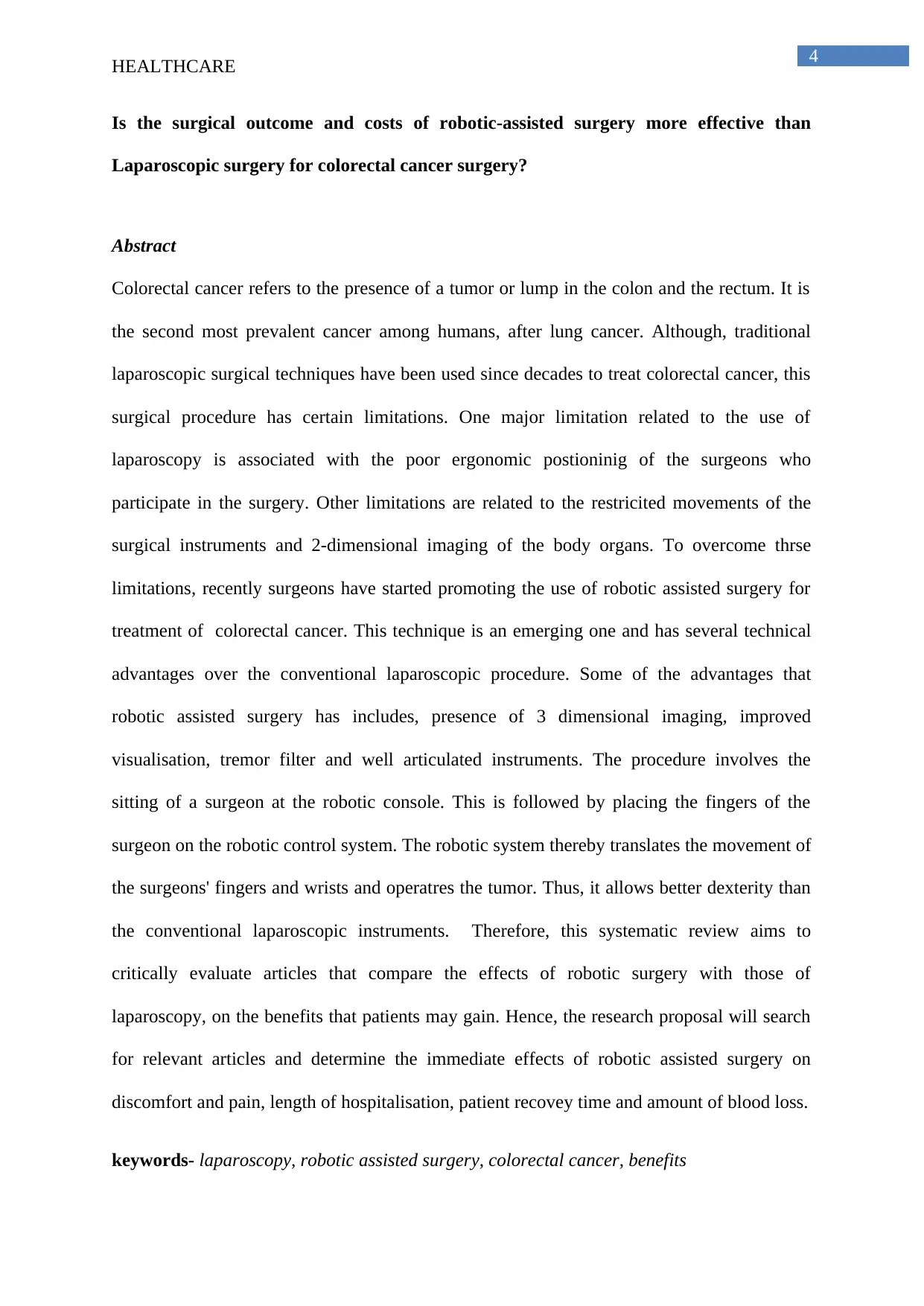
4
HEALTHCARE
Is the surgical outcome and costs of robotic-assisted surgery more effective than
Laparoscopic surgery for colorectal cancer surgery?
Abstract
Colorectal cancer refers to the presence of a tumor or lump in the colon and the rectum. It is
the second most prevalent cancer among humans, after lung cancer. Although, traditional
laparoscopic surgical techniques have been used since decades to treat colorectal cancer, this
surgical procedure has certain limitations. One major limitation related to the use of
laparoscopy is associated with the poor ergonomic postioninig of the surgeons who
participate in the surgery. Other limitations are related to the restricited movements of the
surgical instruments and 2-dimensional imaging of the body organs. To overcome thrse
limitations, recently surgeons have started promoting the use of robotic assisted surgery for
treatment of colorectal cancer. This technique is an emerging one and has several technical
advantages over the conventional laparoscopic procedure. Some of the advantages that
robotic assisted surgery has includes, presence of 3 dimensional imaging, improved
visualisation, tremor filter and well articulated instruments. The procedure involves the
sitting of a surgeon at the robotic console. This is followed by placing the fingers of the
surgeon on the robotic control system. The robotic system thereby translates the movement of
the surgeons' fingers and wrists and operatres the tumor. Thus, it allows better dexterity than
the conventional laparoscopic instruments. Therefore, this systematic review aims to
critically evaluate articles that compare the effects of robotic surgery with those of
laparoscopy, on the benefits that patients may gain. Hence, the research proposal will search
for relevant articles and determine the immediate effects of robotic assisted surgery on
discomfort and pain, length of hospitalisation, patient recovey time and amount of blood loss.
keywords- laparoscopy, robotic assisted surgery, colorectal cancer, benefits
HEALTHCARE
Is the surgical outcome and costs of robotic-assisted surgery more effective than
Laparoscopic surgery for colorectal cancer surgery?
Abstract
Colorectal cancer refers to the presence of a tumor or lump in the colon and the rectum. It is
the second most prevalent cancer among humans, after lung cancer. Although, traditional
laparoscopic surgical techniques have been used since decades to treat colorectal cancer, this
surgical procedure has certain limitations. One major limitation related to the use of
laparoscopy is associated with the poor ergonomic postioninig of the surgeons who
participate in the surgery. Other limitations are related to the restricited movements of the
surgical instruments and 2-dimensional imaging of the body organs. To overcome thrse
limitations, recently surgeons have started promoting the use of robotic assisted surgery for
treatment of colorectal cancer. This technique is an emerging one and has several technical
advantages over the conventional laparoscopic procedure. Some of the advantages that
robotic assisted surgery has includes, presence of 3 dimensional imaging, improved
visualisation, tremor filter and well articulated instruments. The procedure involves the
sitting of a surgeon at the robotic console. This is followed by placing the fingers of the
surgeon on the robotic control system. The robotic system thereby translates the movement of
the surgeons' fingers and wrists and operatres the tumor. Thus, it allows better dexterity than
the conventional laparoscopic instruments. Therefore, this systematic review aims to
critically evaluate articles that compare the effects of robotic surgery with those of
laparoscopy, on the benefits that patients may gain. Hence, the research proposal will search
for relevant articles and determine the immediate effects of robotic assisted surgery on
discomfort and pain, length of hospitalisation, patient recovey time and amount of blood loss.
keywords- laparoscopy, robotic assisted surgery, colorectal cancer, benefits
Paraphrase This Document
Need a fresh take? Get an instant paraphrase of this document with our AI Paraphraser

5
HEALTHCARE
Introduction
Among the most prevalent forms of cancer is colorectal cancer, which again might be
of different forms such as adenocarcinoma, carcinoid tumors and lymphoma. The incidence
of colorectal cancer in the UK is noteworthy, as well as the mortality rate, drawing the
attention of health care professionals to come up with suitable treatment strategies (Siegel et
al. 2017). Colorectal cancer is the fourth most common form of cancer in the country. In both
females and males, it is the third most common form of cancer. There were 41,300 new cases
of colorectal cancer being reported in the year 2014. This implied diagnosis o around 110
cases each day. Around 15,903 deaths occurred in the year 2014 due to this form of cancer.
Colorectal cancer is the second most common cause of cancer in the country and accounts for
10% of all cancer deaths (Stewart and Wild 2017).
Surgery has been denoted as the primary treatment option for a patient suffering from
early-stage colorectal cancer. The form of surgery that is to be undertaken is dependent on the
cancer stage and the primary goal of the surgery. There are certain side effects and risks
associated with colorectal surgery, and these are dependent on diverse factors such as
patient’s general health, the extent of the operation and healthcare environment
(Karayiannakis 2016). According to Niitsu et al. (2016), laparoscopic colorectal cancer
surgery is the most widely used form of treatment and healthcare data points out its
advantageous in comparison to open surgery approach. The benefits that this method has to
include the shorter duration of hospital stay, negligible blood loss due to operation ad less
pain suffered by patients. Though initial concerns regarding the adequacy of the extent of
resection and port-site recurrence had been dismissed, different groups of scholars have
pointed out that laparoscopic surgery is not universally accepted. As opined by Yasui et al.
(2017) laparoscopic surgery is much challenging, and there is a number of concerns
HEALTHCARE
Introduction
Among the most prevalent forms of cancer is colorectal cancer, which again might be
of different forms such as adenocarcinoma, carcinoid tumors and lymphoma. The incidence
of colorectal cancer in the UK is noteworthy, as well as the mortality rate, drawing the
attention of health care professionals to come up with suitable treatment strategies (Siegel et
al. 2017). Colorectal cancer is the fourth most common form of cancer in the country. In both
females and males, it is the third most common form of cancer. There were 41,300 new cases
of colorectal cancer being reported in the year 2014. This implied diagnosis o around 110
cases each day. Around 15,903 deaths occurred in the year 2014 due to this form of cancer.
Colorectal cancer is the second most common cause of cancer in the country and accounts for
10% of all cancer deaths (Stewart and Wild 2017).
Surgery has been denoted as the primary treatment option for a patient suffering from
early-stage colorectal cancer. The form of surgery that is to be undertaken is dependent on the
cancer stage and the primary goal of the surgery. There are certain side effects and risks
associated with colorectal surgery, and these are dependent on diverse factors such as
patient’s general health, the extent of the operation and healthcare environment
(Karayiannakis 2016). According to Niitsu et al. (2016), laparoscopic colorectal cancer
surgery is the most widely used form of treatment and healthcare data points out its
advantageous in comparison to open surgery approach. The benefits that this method has to
include the shorter duration of hospital stay, negligible blood loss due to operation ad less
pain suffered by patients. Though initial concerns regarding the adequacy of the extent of
resection and port-site recurrence had been dismissed, different groups of scholars have
pointed out that laparoscopic surgery is not universally accepted. As opined by Yasui et al.
(2017) laparoscopic surgery is much challenging, and there is a number of concerns
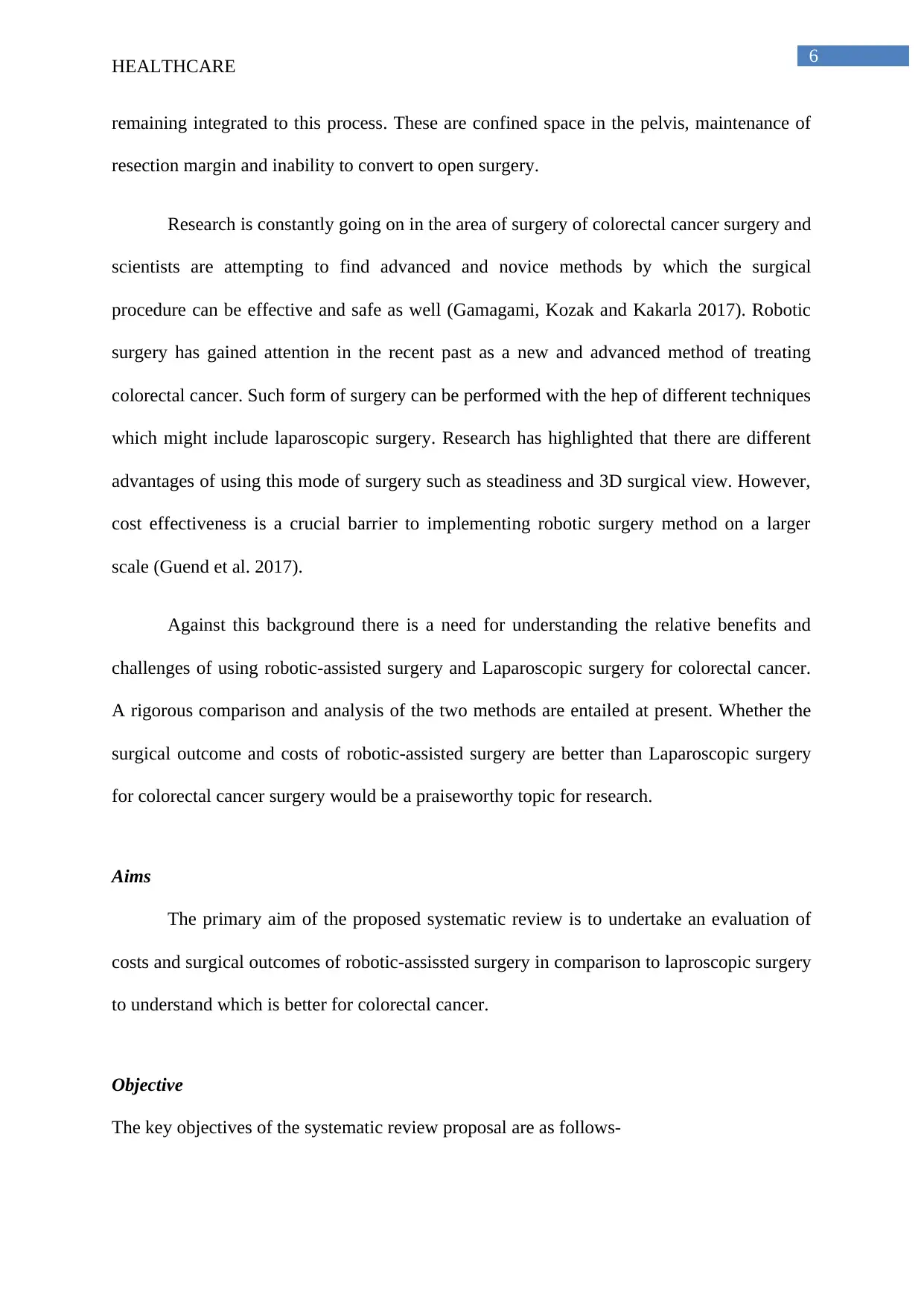
6
HEALTHCARE
remaining integrated to this process. These are confined space in the pelvis, maintenance of
resection margin and inability to convert to open surgery.
Research is constantly going on in the area of surgery of colorectal cancer surgery and
scientists are attempting to find advanced and novice methods by which the surgical
procedure can be effective and safe as well (Gamagami, Kozak and Kakarla 2017). Robotic
surgery has gained attention in the recent past as a new and advanced method of treating
colorectal cancer. Such form of surgery can be performed with the hep of different techniques
which might include laparoscopic surgery. Research has highlighted that there are different
advantages of using this mode of surgery such as steadiness and 3D surgical view. However,
cost effectiveness is a crucial barrier to implementing robotic surgery method on a larger
scale (Guend et al. 2017).
Against this background there is a need for understanding the relative benefits and
challenges of using robotic-assisted surgery and Laparoscopic surgery for colorectal cancer.
A rigorous comparison and analysis of the two methods are entailed at present. Whether the
surgical outcome and costs of robotic-assisted surgery are better than Laparoscopic surgery
for colorectal cancer surgery would be a praiseworthy topic for research.
Aims
The primary aim of the proposed systematic review is to undertake an evaluation of
costs and surgical outcomes of robotic-assissted surgery in comparison to laproscopic surgery
to understand which is better for colorectal cancer.
Objective
The key objectives of the systematic review proposal are as follows-
HEALTHCARE
remaining integrated to this process. These are confined space in the pelvis, maintenance of
resection margin and inability to convert to open surgery.
Research is constantly going on in the area of surgery of colorectal cancer surgery and
scientists are attempting to find advanced and novice methods by which the surgical
procedure can be effective and safe as well (Gamagami, Kozak and Kakarla 2017). Robotic
surgery has gained attention in the recent past as a new and advanced method of treating
colorectal cancer. Such form of surgery can be performed with the hep of different techniques
which might include laparoscopic surgery. Research has highlighted that there are different
advantages of using this mode of surgery such as steadiness and 3D surgical view. However,
cost effectiveness is a crucial barrier to implementing robotic surgery method on a larger
scale (Guend et al. 2017).
Against this background there is a need for understanding the relative benefits and
challenges of using robotic-assisted surgery and Laparoscopic surgery for colorectal cancer.
A rigorous comparison and analysis of the two methods are entailed at present. Whether the
surgical outcome and costs of robotic-assisted surgery are better than Laparoscopic surgery
for colorectal cancer surgery would be a praiseworthy topic for research.
Aims
The primary aim of the proposed systematic review is to undertake an evaluation of
costs and surgical outcomes of robotic-assissted surgery in comparison to laproscopic surgery
to understand which is better for colorectal cancer.
Objective
The key objectives of the systematic review proposal are as follows-
⊘ This is a preview!⊘
Do you want full access?
Subscribe today to unlock all pages.

Trusted by 1+ million students worldwide
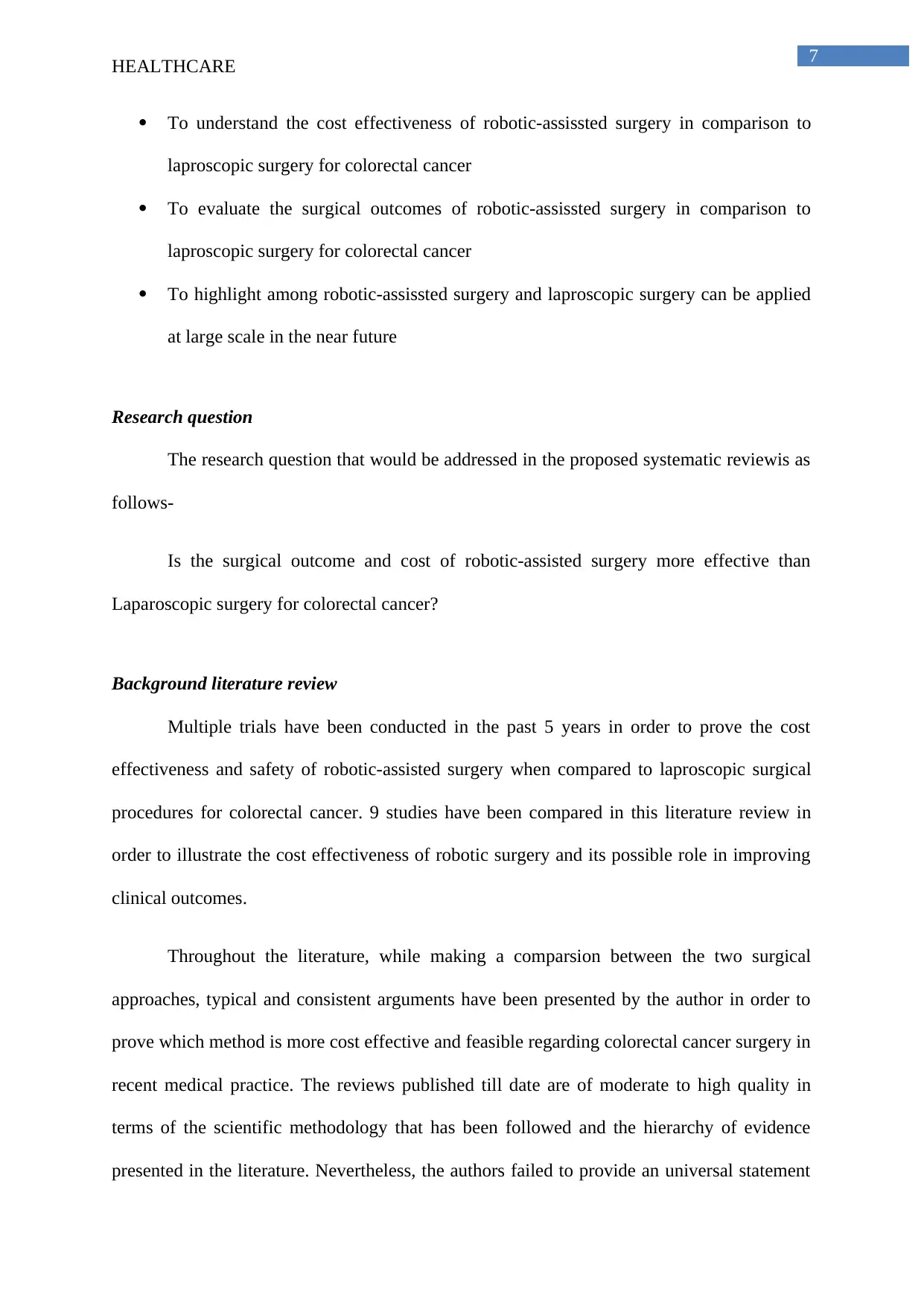
7
HEALTHCARE
To understand the cost effectiveness of robotic-assissted surgery in comparison to
laproscopic surgery for colorectal cancer
To evaluate the surgical outcomes of robotic-assissted surgery in comparison to
laproscopic surgery for colorectal cancer
To highlight among robotic-assissted surgery and laproscopic surgery can be applied
at large scale in the near future
Research question
The research question that would be addressed in the proposed systematic reviewis as
follows-
Is the surgical outcome and cost of robotic-assisted surgery more effective than
Laparoscopic surgery for colorectal cancer?
Background literature review
Multiple trials have been conducted in the past 5 years in order to prove the cost
effectiveness and safety of robotic-assisted surgery when compared to laproscopic surgical
procedures for colorectal cancer. 9 studies have been compared in this literature review in
order to illustrate the cost effectiveness of robotic surgery and its possible role in improving
clinical outcomes.
Throughout the literature, while making a comparsion between the two surgical
approaches, typical and consistent arguments have been presented by the author in order to
prove which method is more cost effective and feasible regarding colorectal cancer surgery in
recent medical practice. The reviews published till date are of moderate to high quality in
terms of the scientific methodology that has been followed and the hierarchy of evidence
presented in the literature. Nevertheless, the authors failed to provide an universal statement
HEALTHCARE
To understand the cost effectiveness of robotic-assissted surgery in comparison to
laproscopic surgery for colorectal cancer
To evaluate the surgical outcomes of robotic-assissted surgery in comparison to
laproscopic surgery for colorectal cancer
To highlight among robotic-assissted surgery and laproscopic surgery can be applied
at large scale in the near future
Research question
The research question that would be addressed in the proposed systematic reviewis as
follows-
Is the surgical outcome and cost of robotic-assisted surgery more effective than
Laparoscopic surgery for colorectal cancer?
Background literature review
Multiple trials have been conducted in the past 5 years in order to prove the cost
effectiveness and safety of robotic-assisted surgery when compared to laproscopic surgical
procedures for colorectal cancer. 9 studies have been compared in this literature review in
order to illustrate the cost effectiveness of robotic surgery and its possible role in improving
clinical outcomes.
Throughout the literature, while making a comparsion between the two surgical
approaches, typical and consistent arguments have been presented by the author in order to
prove which method is more cost effective and feasible regarding colorectal cancer surgery in
recent medical practice. The reviews published till date are of moderate to high quality in
terms of the scientific methodology that has been followed and the hierarchy of evidence
presented in the literature. Nevertheless, the authors failed to provide an universal statement
Paraphrase This Document
Need a fresh take? Get an instant paraphrase of this document with our AI Paraphraser
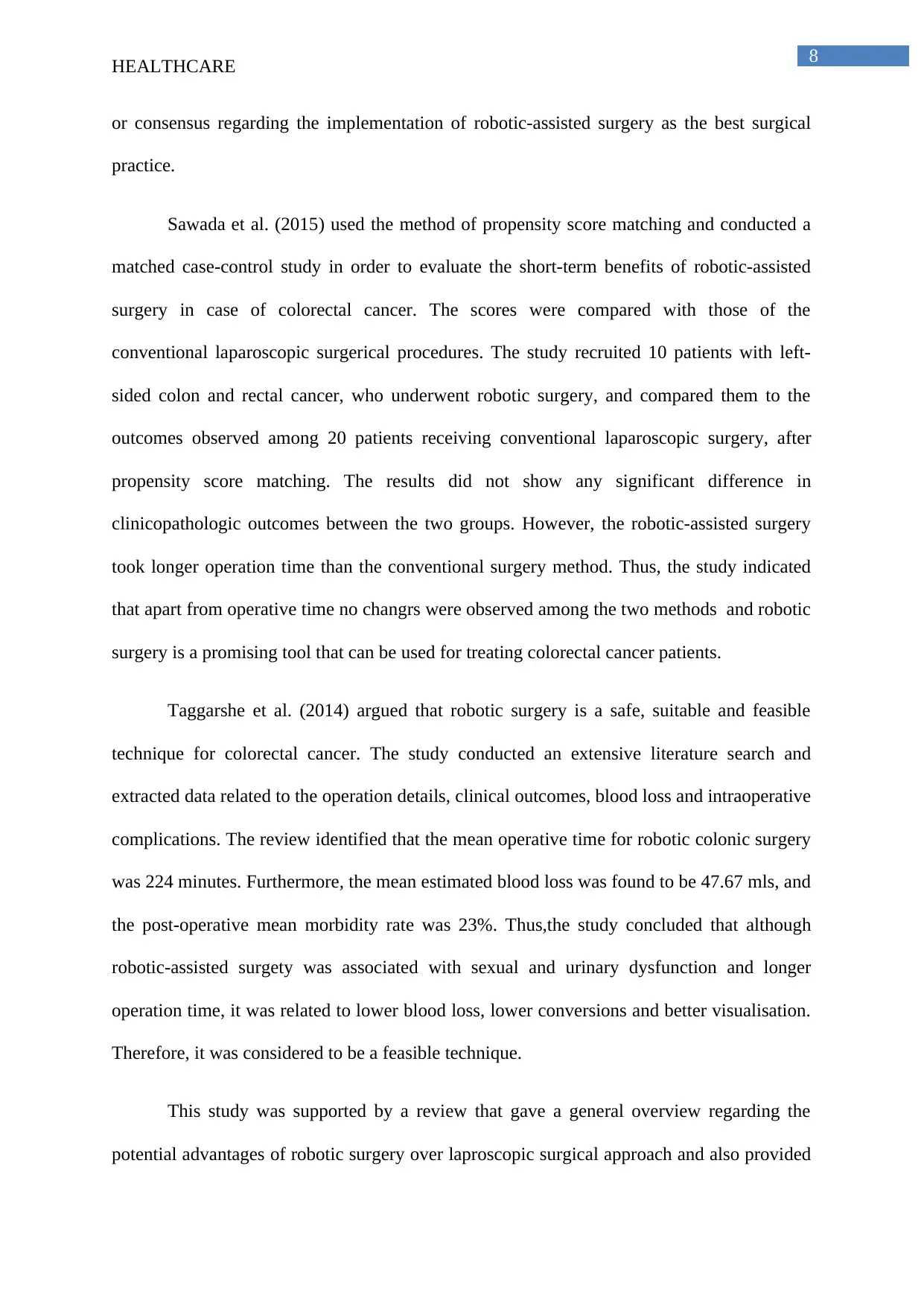
8
HEALTHCARE
or consensus regarding the implementation of robotic-assisted surgery as the best surgical
practice.
Sawada et al. (2015) used the method of propensity score matching and conducted a
matched case-control study in order to evaluate the short-term benefits of robotic-assisted
surgery in case of colorectal cancer. The scores were compared with those of the
conventional laparoscopic surgerical procedures. The study recruited 10 patients with left-
sided colon and rectal cancer, who underwent robotic surgery, and compared them to the
outcomes observed among 20 patients receiving conventional laparoscopic surgery, after
propensity score matching. The results did not show any significant difference in
clinicopathologic outcomes between the two groups. However, the robotic-assisted surgery
took longer operation time than the conventional surgery method. Thus, the study indicated
that apart from operative time no changrs were observed among the two methods and robotic
surgery is a promising tool that can be used for treating colorectal cancer patients.
Taggarshe et al. (2014) argued that robotic surgery is a safe, suitable and feasible
technique for colorectal cancer. The study conducted an extensive literature search and
extracted data related to the operation details, clinical outcomes, blood loss and intraoperative
complications. The review identified that the mean operative time for robotic colonic surgery
was 224 minutes. Furthermore, the mean estimated blood loss was found to be 47.67 mls, and
the post-operative mean morbidity rate was 23%. Thus,the study concluded that although
robotic-assisted surgety was associated with sexual and urinary dysfunction and longer
operation time, it was related to lower blood loss, lower conversions and better visualisation.
Therefore, it was considered to be a feasible technique.
This study was supported by a review that gave a general overview regarding the
potential advantages of robotic surgery over laproscopic surgical approach and also provided
HEALTHCARE
or consensus regarding the implementation of robotic-assisted surgery as the best surgical
practice.
Sawada et al. (2015) used the method of propensity score matching and conducted a
matched case-control study in order to evaluate the short-term benefits of robotic-assisted
surgery in case of colorectal cancer. The scores were compared with those of the
conventional laparoscopic surgerical procedures. The study recruited 10 patients with left-
sided colon and rectal cancer, who underwent robotic surgery, and compared them to the
outcomes observed among 20 patients receiving conventional laparoscopic surgery, after
propensity score matching. The results did not show any significant difference in
clinicopathologic outcomes between the two groups. However, the robotic-assisted surgery
took longer operation time than the conventional surgery method. Thus, the study indicated
that apart from operative time no changrs were observed among the two methods and robotic
surgery is a promising tool that can be used for treating colorectal cancer patients.
Taggarshe et al. (2014) argued that robotic surgery is a safe, suitable and feasible
technique for colorectal cancer. The study conducted an extensive literature search and
extracted data related to the operation details, clinical outcomes, blood loss and intraoperative
complications. The review identified that the mean operative time for robotic colonic surgery
was 224 minutes. Furthermore, the mean estimated blood loss was found to be 47.67 mls, and
the post-operative mean morbidity rate was 23%. Thus,the study concluded that although
robotic-assisted surgety was associated with sexual and urinary dysfunction and longer
operation time, it was related to lower blood loss, lower conversions and better visualisation.
Therefore, it was considered to be a feasible technique.
This study was supported by a review that gave a general overview regarding the
potential advantages of robotic surgery over laproscopic surgical approach and also provided
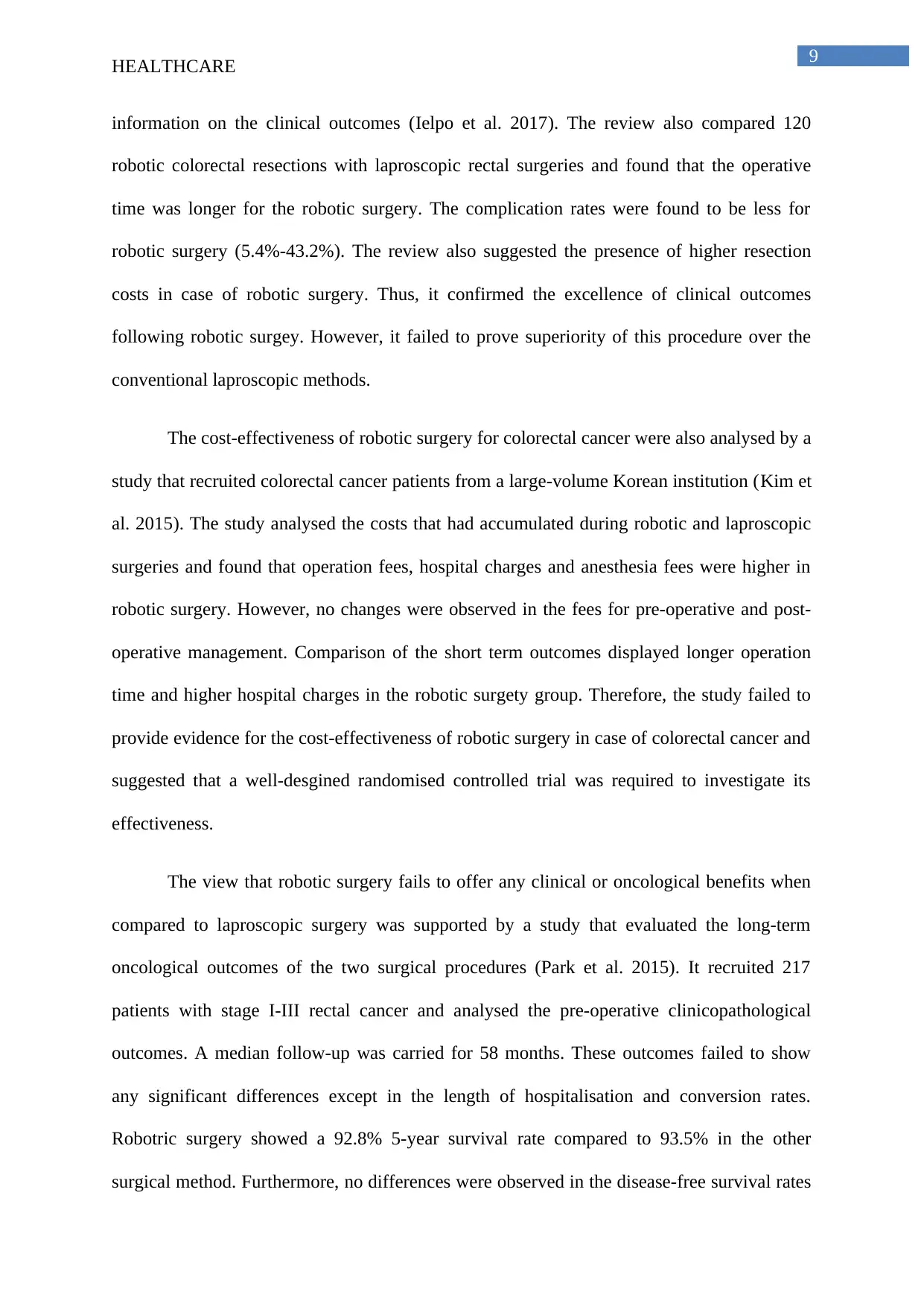
9
HEALTHCARE
information on the clinical outcomes (Ielpo et al. 2017). The review also compared 120
robotic colorectal resections with laproscopic rectal surgeries and found that the operative
time was longer for the robotic surgery. The complication rates were found to be less for
robotic surgery (5.4%-43.2%). The review also suggested the presence of higher resection
costs in case of robotic surgery. Thus, it confirmed the excellence of clinical outcomes
following robotic surgey. However, it failed to prove superiority of this procedure over the
conventional laproscopic methods.
The cost-effectiveness of robotic surgery for colorectal cancer were also analysed by a
study that recruited colorectal cancer patients from a large-volume Korean institution (Kim et
al. 2015). The study analysed the costs that had accumulated during robotic and laproscopic
surgeries and found that operation fees, hospital charges and anesthesia fees were higher in
robotic surgery. However, no changes were observed in the fees for pre-operative and post-
operative management. Comparison of the short term outcomes displayed longer operation
time and higher hospital charges in the robotic surgety group. Therefore, the study failed to
provide evidence for the cost-effectiveness of robotic surgery in case of colorectal cancer and
suggested that a well-desgined randomised controlled trial was required to investigate its
effectiveness.
The view that robotic surgery fails to offer any clinical or oncological benefits when
compared to laproscopic surgery was supported by a study that evaluated the long-term
oncological outcomes of the two surgical procedures (Park et al. 2015). It recruited 217
patients with stage I-III rectal cancer and analysed the pre-operative clinicopathological
outcomes. A median follow-up was carried for 58 months. These outcomes failed to show
any significant differences except in the length of hospitalisation and conversion rates.
Robotric surgery showed a 92.8% 5-year survival rate compared to 93.5% in the other
surgical method. Furthermore, no differences were observed in the disease-free survival rates
HEALTHCARE
information on the clinical outcomes (Ielpo et al. 2017). The review also compared 120
robotic colorectal resections with laproscopic rectal surgeries and found that the operative
time was longer for the robotic surgery. The complication rates were found to be less for
robotic surgery (5.4%-43.2%). The review also suggested the presence of higher resection
costs in case of robotic surgery. Thus, it confirmed the excellence of clinical outcomes
following robotic surgey. However, it failed to prove superiority of this procedure over the
conventional laproscopic methods.
The cost-effectiveness of robotic surgery for colorectal cancer were also analysed by a
study that recruited colorectal cancer patients from a large-volume Korean institution (Kim et
al. 2015). The study analysed the costs that had accumulated during robotic and laproscopic
surgeries and found that operation fees, hospital charges and anesthesia fees were higher in
robotic surgery. However, no changes were observed in the fees for pre-operative and post-
operative management. Comparison of the short term outcomes displayed longer operation
time and higher hospital charges in the robotic surgety group. Therefore, the study failed to
provide evidence for the cost-effectiveness of robotic surgery in case of colorectal cancer and
suggested that a well-desgined randomised controlled trial was required to investigate its
effectiveness.
The view that robotic surgery fails to offer any clinical or oncological benefits when
compared to laproscopic surgery was supported by a study that evaluated the long-term
oncological outcomes of the two surgical procedures (Park et al. 2015). It recruited 217
patients with stage I-III rectal cancer and analysed the pre-operative clinicopathological
outcomes. A median follow-up was carried for 58 months. These outcomes failed to show
any significant differences except in the length of hospitalisation and conversion rates.
Robotric surgery showed a 92.8% 5-year survival rate compared to 93.5% in the other
surgical method. Furthermore, no differences were observed in the disease-free survival rates
⊘ This is a preview!⊘
Do you want full access?
Subscribe today to unlock all pages.

Trusted by 1+ million students worldwide

10
HEALTHCARE
and local recurrence rates. Therefore, despite an increased cost, it could not be concluded
that robotic surgery provides a better clinical benefit compared to laproscopy.
The fact that robotic surgery confers a better clinical outcome was argues by a
randomised clinical trial that compared it to conventional laproscopic surgery (Jayne et al.
2017). 471 patients with rectal adenocarcinoma fit for resection were selected from 29 sites,
across 10 countries and a follow-up was conducted. Conversion to open laparotomy was
considered as the primary outcome. The overall rate of conversion was found to be around
10.1% and the overall CRM+ rate was around 5.7%. No statistical difference was observed
between the 2 groups with respect to sexual dysfunction, bladder dysfunction, post-operative
complications and mortality. Thus, the findings suggested that when surgeons with different
experiences perfrom robotic surgery, no advantage is conferred on resection of rectal cancer.
Another study compared the costs and surgical parameters between 25 laproscopic
and 50 robotic surgeries and gathered information on demographic features, surgical
procedures and outcomes (Morelli et al. 2016). On collecting and differentiating the costs
into fixed and variable units, the robotic learning curve was found. This showed a significant
lowering of median operative time and mean costs in laproscopic procedures. The findings
suggested that reduction in operation time and optimisation of instruments contributed to the
improvement in hospitalisation costs in the long run. Thus, the study suggested that although,
robotic surgery is more expensive, efforts to reduce fixed costs are required in order to
mantain the sustainability of the procedure.
The findings were further supported by Tyler et al. (2013) in a restrospective review
that compared the costs and in-hospital outcomes between patients undergoing the two kinds
of surgeries. On using a regression model to compae the procedural outcome differences
while controlling the baseline difference it was found that there was no significant difference
HEALTHCARE
and local recurrence rates. Therefore, despite an increased cost, it could not be concluded
that robotic surgery provides a better clinical benefit compared to laproscopy.
The fact that robotic surgery confers a better clinical outcome was argues by a
randomised clinical trial that compared it to conventional laproscopic surgery (Jayne et al.
2017). 471 patients with rectal adenocarcinoma fit for resection were selected from 29 sites,
across 10 countries and a follow-up was conducted. Conversion to open laparotomy was
considered as the primary outcome. The overall rate of conversion was found to be around
10.1% and the overall CRM+ rate was around 5.7%. No statistical difference was observed
between the 2 groups with respect to sexual dysfunction, bladder dysfunction, post-operative
complications and mortality. Thus, the findings suggested that when surgeons with different
experiences perfrom robotic surgery, no advantage is conferred on resection of rectal cancer.
Another study compared the costs and surgical parameters between 25 laproscopic
and 50 robotic surgeries and gathered information on demographic features, surgical
procedures and outcomes (Morelli et al. 2016). On collecting and differentiating the costs
into fixed and variable units, the robotic learning curve was found. This showed a significant
lowering of median operative time and mean costs in laproscopic procedures. The findings
suggested that reduction in operation time and optimisation of instruments contributed to the
improvement in hospitalisation costs in the long run. Thus, the study suggested that although,
robotic surgery is more expensive, efforts to reduce fixed costs are required in order to
mantain the sustainability of the procedure.
The findings were further supported by Tyler et al. (2013) in a restrospective review
that compared the costs and in-hospital outcomes between patients undergoing the two kinds
of surgeries. On using a regression model to compae the procedural outcome differences
while controlling the baseline difference it was found that there was no significant difference
Paraphrase This Document
Need a fresh take? Get an instant paraphrase of this document with our AI Paraphraser
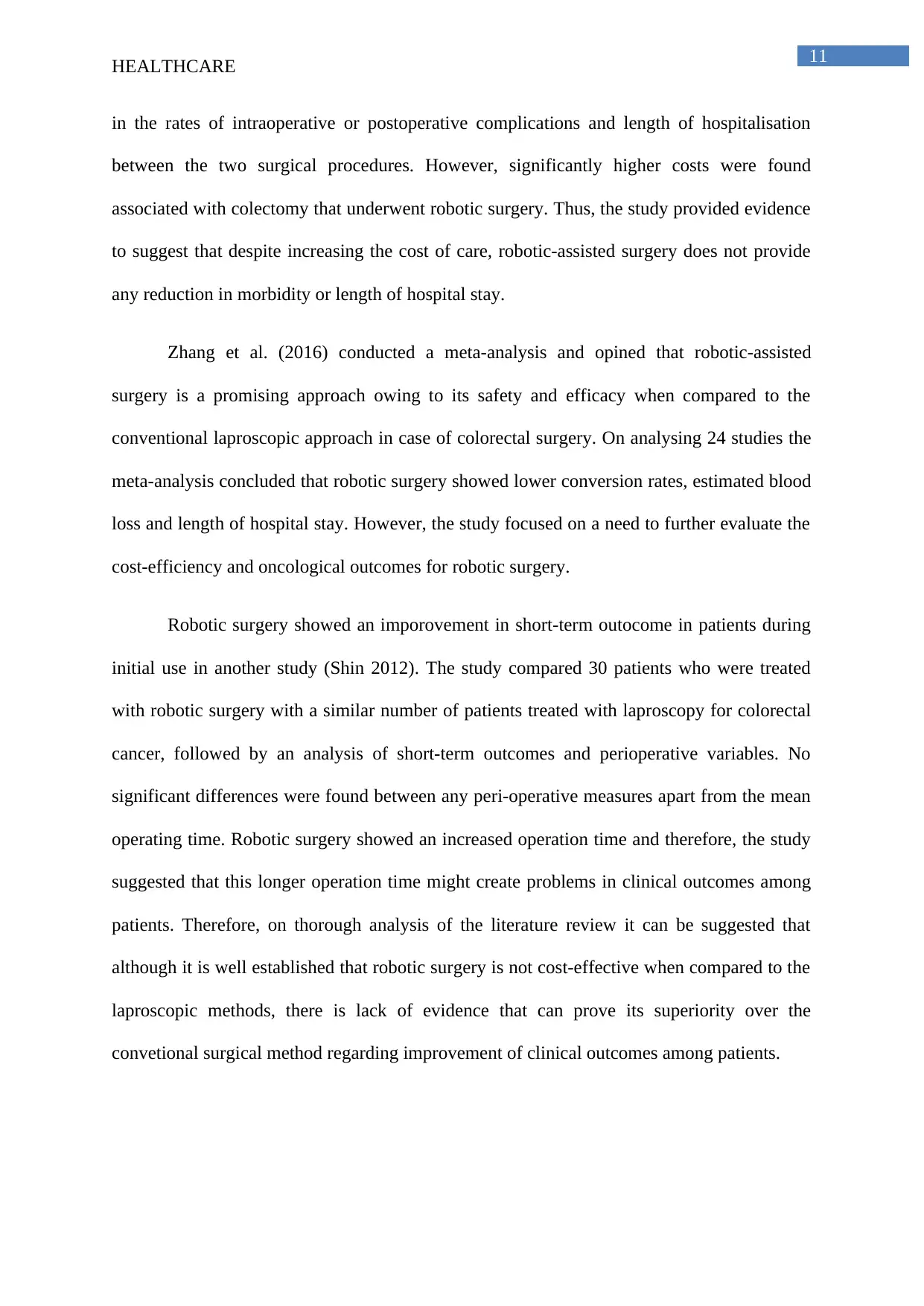
11
HEALTHCARE
in the rates of intraoperative or postoperative complications and length of hospitalisation
between the two surgical procedures. However, significantly higher costs were found
associated with colectomy that underwent robotic surgery. Thus, the study provided evidence
to suggest that despite increasing the cost of care, robotic-assisted surgery does not provide
any reduction in morbidity or length of hospital stay.
Zhang et al. (2016) conducted a meta-analysis and opined that robotic-assisted
surgery is a promising approach owing to its safety and efficacy when compared to the
conventional laproscopic approach in case of colorectal surgery. On analysing 24 studies the
meta-analysis concluded that robotic surgery showed lower conversion rates, estimated blood
loss and length of hospital stay. However, the study focused on a need to further evaluate the
cost-efficiency and oncological outcomes for robotic surgery.
Robotic surgery showed an imporovement in short-term outocome in patients during
initial use in another study (Shin 2012). The study compared 30 patients who were treated
with robotic surgery with a similar number of patients treated with laproscopy for colorectal
cancer, followed by an analysis of short-term outcomes and perioperative variables. No
significant differences were found between any peri-operative measures apart from the mean
operating time. Robotic surgery showed an increased operation time and therefore, the study
suggested that this longer operation time might create problems in clinical outcomes among
patients. Therefore, on thorough analysis of the literature review it can be suggested that
although it is well established that robotic surgery is not cost-effective when compared to the
laproscopic methods, there is lack of evidence that can prove its superiority over the
convetional surgical method regarding improvement of clinical outcomes among patients.
HEALTHCARE
in the rates of intraoperative or postoperative complications and length of hospitalisation
between the two surgical procedures. However, significantly higher costs were found
associated with colectomy that underwent robotic surgery. Thus, the study provided evidence
to suggest that despite increasing the cost of care, robotic-assisted surgery does not provide
any reduction in morbidity or length of hospital stay.
Zhang et al. (2016) conducted a meta-analysis and opined that robotic-assisted
surgery is a promising approach owing to its safety and efficacy when compared to the
conventional laproscopic approach in case of colorectal surgery. On analysing 24 studies the
meta-analysis concluded that robotic surgery showed lower conversion rates, estimated blood
loss and length of hospital stay. However, the study focused on a need to further evaluate the
cost-efficiency and oncological outcomes for robotic surgery.
Robotic surgery showed an imporovement in short-term outocome in patients during
initial use in another study (Shin 2012). The study compared 30 patients who were treated
with robotic surgery with a similar number of patients treated with laproscopy for colorectal
cancer, followed by an analysis of short-term outcomes and perioperative variables. No
significant differences were found between any peri-operative measures apart from the mean
operating time. Robotic surgery showed an increased operation time and therefore, the study
suggested that this longer operation time might create problems in clinical outcomes among
patients. Therefore, on thorough analysis of the literature review it can be suggested that
although it is well established that robotic surgery is not cost-effective when compared to the
laproscopic methods, there is lack of evidence that can prove its superiority over the
convetional surgical method regarding improvement of clinical outcomes among patients.
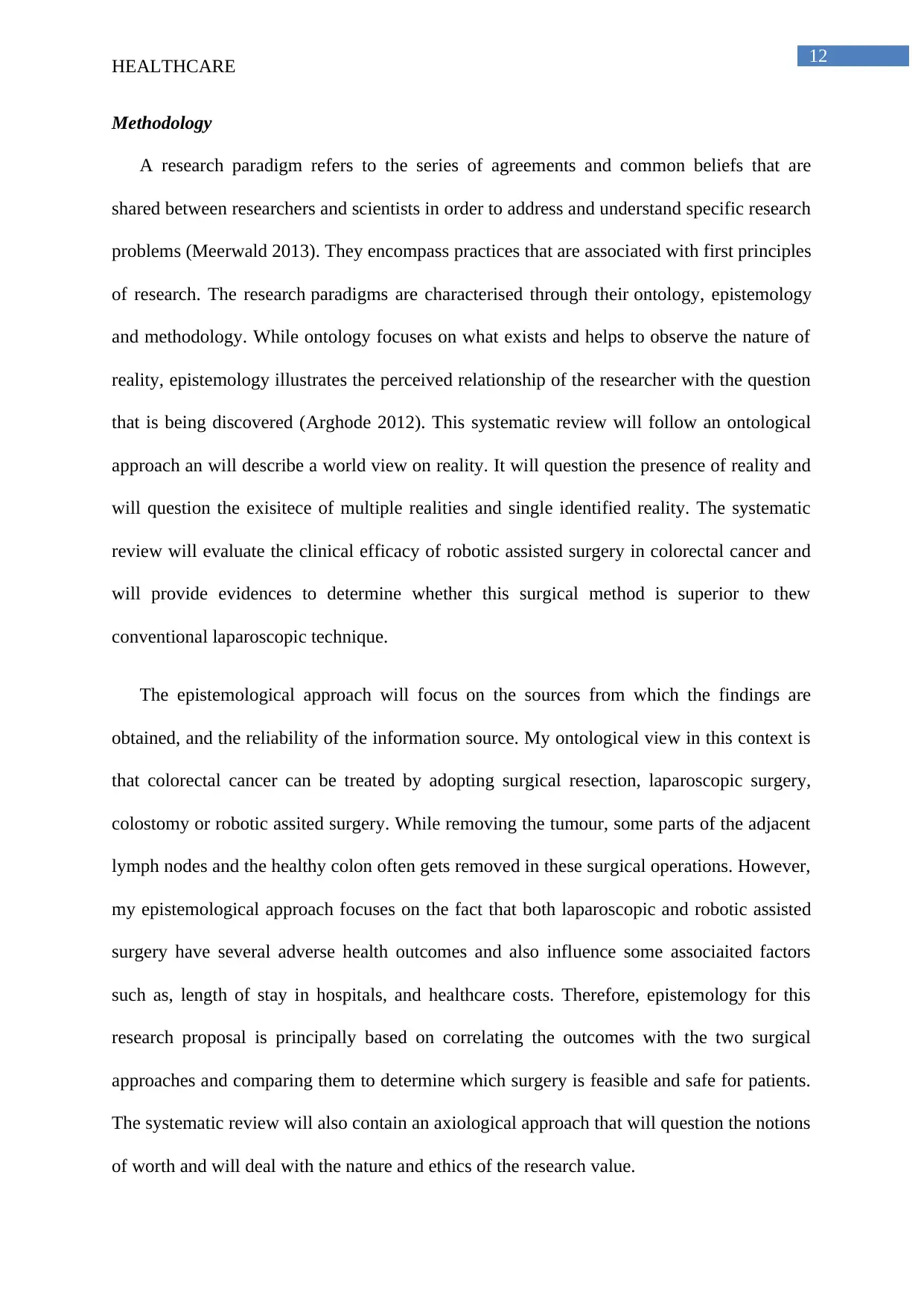
12
HEALTHCARE
Methodology
A research paradigm refers to the series of agreements and common beliefs that are
shared between researchers and scientists in order to address and understand specific research
problems (Meerwald 2013). They encompass practices that are associated with first principles
of research. The research paradigms are characterised through their ontology, epistemology
and methodology. While ontology focuses on what exists and helps to observe the nature of
reality, epistemology illustrates the perceived relationship of the researcher with the question
that is being discovered (Arghode 2012). This systematic review will follow an ontological
approach an will describe a world view on reality. It will question the presence of reality and
will question the exisitece of multiple realities and single identified reality. The systematic
review will evaluate the clinical efficacy of robotic assisted surgery in colorectal cancer and
will provide evidences to determine whether this surgical method is superior to thew
conventional laparoscopic technique.
The epistemological approach will focus on the sources from which the findings are
obtained, and the reliability of the information source. My ontological view in this context is
that colorectal cancer can be treated by adopting surgical resection, laparoscopic surgery,
colostomy or robotic assited surgery. While removing the tumour, some parts of the adjacent
lymph nodes and the healthy colon often gets removed in these surgical operations. However,
my epistemological approach focuses on the fact that both laparoscopic and robotic assisted
surgery have several adverse health outcomes and also influence some associaited factors
such as, length of stay in hospitals, and healthcare costs. Therefore, epistemology for this
research proposal is principally based on correlating the outcomes with the two surgical
approaches and comparing them to determine which surgery is feasible and safe for patients.
The systematic review will also contain an axiological approach that will question the notions
of worth and will deal with the nature and ethics of the research value.
HEALTHCARE
Methodology
A research paradigm refers to the series of agreements and common beliefs that are
shared between researchers and scientists in order to address and understand specific research
problems (Meerwald 2013). They encompass practices that are associated with first principles
of research. The research paradigms are characterised through their ontology, epistemology
and methodology. While ontology focuses on what exists and helps to observe the nature of
reality, epistemology illustrates the perceived relationship of the researcher with the question
that is being discovered (Arghode 2012). This systematic review will follow an ontological
approach an will describe a world view on reality. It will question the presence of reality and
will question the exisitece of multiple realities and single identified reality. The systematic
review will evaluate the clinical efficacy of robotic assisted surgery in colorectal cancer and
will provide evidences to determine whether this surgical method is superior to thew
conventional laparoscopic technique.
The epistemological approach will focus on the sources from which the findings are
obtained, and the reliability of the information source. My ontological view in this context is
that colorectal cancer can be treated by adopting surgical resection, laparoscopic surgery,
colostomy or robotic assited surgery. While removing the tumour, some parts of the adjacent
lymph nodes and the healthy colon often gets removed in these surgical operations. However,
my epistemological approach focuses on the fact that both laparoscopic and robotic assisted
surgery have several adverse health outcomes and also influence some associaited factors
such as, length of stay in hospitals, and healthcare costs. Therefore, epistemology for this
research proposal is principally based on correlating the outcomes with the two surgical
approaches and comparing them to determine which surgery is feasible and safe for patients.
The systematic review will also contain an axiological approach that will question the notions
of worth and will deal with the nature and ethics of the research value.
⊘ This is a preview!⊘
Do you want full access?
Subscribe today to unlock all pages.

Trusted by 1+ million students worldwide
1 out of 49
Your All-in-One AI-Powered Toolkit for Academic Success.
+13062052269
info@desklib.com
Available 24*7 on WhatsApp / Email
![[object Object]](/_next/static/media/star-bottom.7253800d.svg)
Unlock your academic potential
Copyright © 2020–2025 A2Z Services. All Rights Reserved. Developed and managed by ZUCOL.